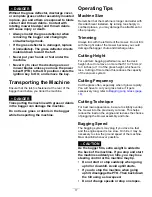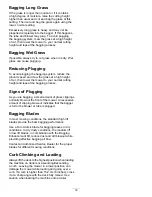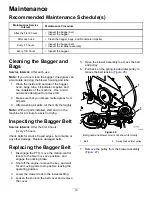
•
Become familiar with the safe operation of the
equipment, with the operator controls, and safety
signs.
•
Use extra care with grass catchers or other
attachments. These can change the operating
characteristics and the stability of the machine.
•
Follow the recommendations for adding or
removing weights as described in the
Operator’s
Manual
for the machine.
•
Do not use a grass catcher on steep slopes. A
heavy grass catcher could cause loss of control
or overturn the machine.
•
Slow down and use extra care on hillsides. Mow
slopes side to side. Turf conditions can affect the
stability of the machine. Use extreme caution
while operating near drop-offs.
•
Keep all movement on slopes slow and gradual.
Do not make sudden changes in speed, directions,
or turning.
•
The grass catcher can obstruct the view to the
rear. Use extra care when operating the machine
in reverse.
•
Use care when loading or unloading the machine
into a trailer or truck.
•
Never operate with the discharge deflector raised,
removed, or altered, unless you are using a grass
catcher.
•
Keep your hands and feet away from moving parts.
Do not make adjustments with the engine running.
•
Stop the machine on level ground, disengage the
drives, set the parking brake, and shut off the
engine before leaving the operator's position for
any reason including emptying the grass catcher
or unclogging the chute.
•
Do not operate the machine without either the
entire grass catcher, the grass deflector, and/or
guard in place.
•
Shut off the engine before removing the grass
catcher or unclogging the chute.
•
Do not leave grass in the grass catcher for
extended periods of time.
•
Grass catcher components are subject to wear,
damage, and deterioration, which could expose
you to moving parts or thrown objects. Frequently
check components and replace them with
the manufacturer's recommended parts when
necessary.
4



















